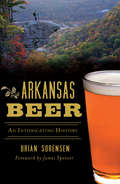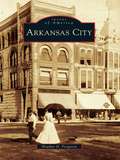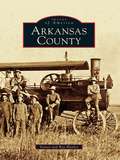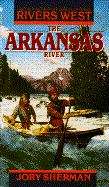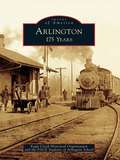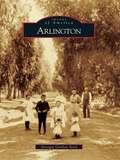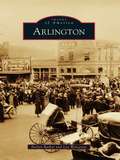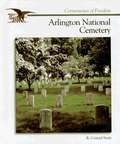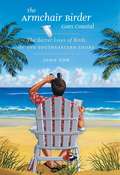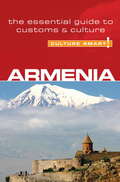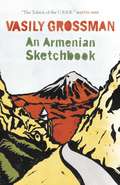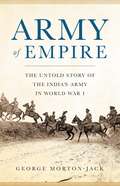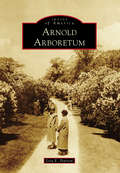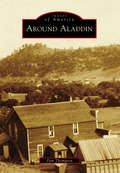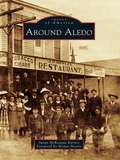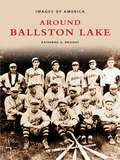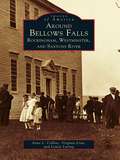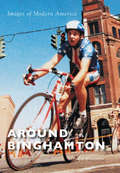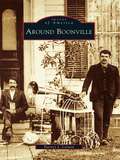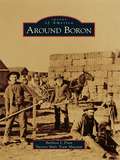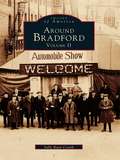- Table View
- List View
Arkansas Beer: An Intoxicating History (American Palate)
by James Spencer Brian SorensenArkansas�s booze scene had a promising start, with America�s biggest brewing families, Busch and Lemp, investing in Little Rock just prior to Prohibition. However, by 1915, the state had passed the Newberry Act, banning the manufacturing and selling of alcohol. It was not until sixty-nine years later that the state welcomed its first post-temperance brewery, Arkansas Brewing Company. After a few false starts, brewpubs in Fayetteville, Fort Smith and Little Rock found success. By 2000, the industry had regained momentum. An explosion of breweries around the state has since propelled Arkansas into the modern beer age.
Arkansas City: People, Places, And Events (Images of America)
by Heather D. FergusonArkansas City has often been called "the gateway to the West." The name lends a lot to describing the town--a town that was founded as a border town to Indian Territory, a major trade hub to the Indian agencies in Indian Territory, and a major transportation center for those wishing to travel through the territory and farther west. Arkansas City started off as a small town with false-fronted stores but became a bustling community where the people were forward thinkers and pushed for quality and modernization in everything they brought to the city whether that was business, industry, or entertainment. Arkansas City is known for the Cherokee Strip Land Rush of September 16, 1893, interaction with the Native Americans in Indian Territory, farming, ranching, and aircraft. Although Arkansas City was a civilized community, it was a city on the fringe of a lawless and unsettled territory where outlaws lurked and Native Americans were forced to settle. People loaded their wagons or went by train to cross through Oklahoma to Texas, New Mexico, or Arizona, leaving from Arkansas City. Due to Arkansas City's location, interaction with major figures and events in history, and its importance to travel farther west, Arkansas City was truly "the gateway to the West."
Arkansas County: Arkansas (Images of America)
by Ray Hanley Steven HanleyFirst established by the French in 1686, Arkansas Post was the first permanent European settlement in the Mississippi River Valley. It played a key role in the long struggle between France, Spain, and England for control of the lucrative fur trade. The only battle of the American Revolution fought west of the Mississippi took place in Arkansas County. Located in the heart of the Grand Prairie, Stuttgart, one of two Arkansas County seats, is known as the "duck and rice capital of the world." Bayou Meto and several lakes draw waterfowl to the area each fall, and ducks flocking to Stuttgart attract hunters from across the nation. Each November, the community hosts the World Championship Duck Calling Contest.
The Arkansas River (Rivers West, #6)
by Jory ShermanEastward, as far as the eye could see, stretched the Great Plains. Westward rose the Rockies, snowcapped shadows against the sky. In the middle flowed a mighty river-- silent, glistening, and turbulent--the bloodline of a wide and wild land. Three hard, tough men staked their claims on its potent shores; Jake Stonecipher, pioneer merchant, seeking his fortune--yet finding a war. Will Burke, a mountain man as savage as the wilderness itself. And Francisco Serrano, determined to carve a fertile ranch out of the stubborn soil. Three men blazing trails, forging a future...building lives as bold-- and as treacherous--as the Arkansas River.
Arlington: 175 Years
by Eagle Creek Historical Organization PACE students of Arlington SchoolIn 1834, Robert Hurd and his family settled on a parcel of land in what is now present-day Arlington. A devout Presbyterian, Hurd named the town after his favorite church hymn. In the late 1800s, the small town of Arlington saw progress in the form of two railroads. The mid-1930s were especially prosperous, as the town enjoyed a bustling business center that included six grocery stores. The famous Arlington Homecoming Festival began in 1946 and ran for 50 years. In the 1990s, George Herbert Bush and William Jefferson Clinton made presidential campaign stops here, making history in this quiet, small town. The heart of this town can be found in its citizens, their churches, schools, and businesses, and their community park. Current and former residents alike share fond memories of their small-town lifestyle and are proud to be Arlingtonians.
Arlington (Images of America)
by Georgia Gordon SerclThe neighborhood of Arlington, located about five miles southwest of downtown Riverside, was first settled in the 1870s and was later developed as a town site in 1877 by philanthropist Samuel C. Evans and William Sayward. Citrus groves flourished in the area, providing the community with a newfound wealth. Large and gracious homes were built on wide streets lined with beautiful shade trees. Arlington's commercial district at Van Buren Boulevard and Magnolia Avenue expanded to include a bank, chamber of commerce, newspaper, store, church, boardinghouse, and post office with its own Arlington postmark, in use since 1888. In the early 1900s, an electric railway was built down the center of Magnolia Avenue ending at beautiful Chemewa Park with its large trees, dance pavilion, zoo, and polo field. Today Arlington retains much of its neighborhood feeling while undergoing a large-scale redevelopment project for a future retail and commercial district.
Arlington
by Lea Worcester Evelyn BarkerHistorians dispute the founding of Arlington. Some say Arlington started in 1848 when Col. Middleton Tate Johnson started the settlement called Johnson's Station, a forerunner of Arlington. Others say it was 1876, when the railroad arrived, or 1877, when the post office was established. Still others claim 1884 as the founding, because that was when city leaders incorporated Arlington, naming the town after the home of Gen. Robert E. Lee. Whatever date one chooses for the founding, there is no question that Arlington has grown from its frontier origins into the entertainment center of North Texas. Highlights of Arlington's development include Depression-era gambling at Top O' Hill and Arlington Downs, Progressive values in the Berachah Home for Erring Girls, higher education through the University of Texas at Arlington, and economic expansion with General Motors. More recently, energetic citizens like former mayor Tommy Vandergriff helped bring two professional sports teams to Arlington. Today the Texas Rangers and Dallas Cowboys share top billing with the city's other signature attractions--Six Flags Over Texas and Hurricane Harbor.
Arlington National Cemetery (Cornerstones of Freedom)
by R. Conrad SteinArlington is one of 114 national cemeteries maintained by the United States government. The major purpose of a national cemetery is to serve as a burial place for veterans of the country's armed forces. Situated across the Potomac River from Washington, D.C., Arlington has long been close to many Americans' hearts. It is the final home of citizens from all backgrounds. Buried there are ex-presidents as well as former slaves.
An Armadillo in Paris
by Julie KraulisA winsome armadillo from Brazil takes a trip to Paris in this delightful new picture book from Julie Kraulis. Arlo is an armadillo who is always up for adventure. His grandfather, Augustin, loved adventure too. When Arlo was born, Augustin wrote travel journals about his favorite places for Arlo to use when he was hold enough to go exploring on his own. When Arlo reads about Paris and the one the French call La Dame de Fer, or Iron Lady, he decides it's time to strike out on his first adventure. He travels to France and, guided by Augustin's journal, discovers the joys of Paris: eating a flakey croissant at a café, visiting the Louvre, walking along the Seine and, of course, meeting the Iron Lady... But who is she? Each spread has a clue about her identity, and kids will see hints of her scattered throughout the book. This book is like a gorgeous stroll through Paris with an adorable new friend--a stroll you'll want to take again and again.
The Armchair Birder Goes Coastal
by John YowWith his distinctively witty, anecdotal, and disarming voice, John Yow now journeys to the shore and shares his encounters with some of the most familiar and beloved coastal birds. Out of his travels--from North Carolina's Outer Banks, down the Atlantic coast, and westward along the Gulf of Mexico--come colorful accounts of twenty-eight species, from ubiquitous beach birds like sanderlings and laughing gulls to wonders of nature like roseate spoonbills and the American avocets. Along the way, Yow delves deeply into the birds' habits and behaviors, experiencing and relating the fascination that leads many an amateur naturalist to become the most unusual of species--a birder.Seasonally organized chapters explore the improbable, the wonderful, and the amusing aspects of these birds' lives. Yow embellishes his observations with field notes, anecdotes, and stories from some of America's finest naturalists--including John James Audubon, Arthur Cleveland Bent, Rachel Carson, and Peter Matthiessen. Combining the endless fascination of bird life with the pleasure of good reading, The Armchair Birder Goes Coastal is the perfect companion for any nature lover's next trip to the beach.
The Armchair Birder's Omnibus Ebook
by John YowAvailable for the first time together in this Omnibus E-Book, The Armchair Birder's Omnibus brings together both of John Yow's delightful books into one convenient e-book.While birding literature is filled with tales of expert observers spotting rare species in exotic locales, John Yow reminds us in The Armchair Birder, that the most fascinating birds can be the ones perched right outside our windows. In thirty-five engaging and sometimes irreverent vignettes, Yow reveals the fascinating lives of the birds we see nearly every day. Following the seasons, he covers forty-two species, discussing the improbable, unusual, and comical aspects of his subjects' lives. Yow offers his own observations, anecdotes, and stories as well as those of America's classic bird writers, such as John James Audubon, Arthur Bent, and Edward Forbush. This unique addition to bird literature combines the fascination of bird life with the pleasure of good reading.In his follow-up volume The Armchair Birder Goes Coastal, Yow now journeys to the shore and shares his encounters with some of the most familiar and beloved coastal birds. Out of his travels--from North Carolina's Outer Banks, down the Atlantic coast, and westward along the Gulf of Mexico--come colorful accounts of twenty-eight species, from ubiquitous beach birds like sanderlings and laughing gulls to wonders of nature like roseate spoonbills and the American avocets. Along the way, Yow delves deeply into the birds' habits and behaviors, experiencing and relating the fascination that leads many an amateur naturalist to become the most unusual of species--a birder.
Armenia - Culture Smart!: The Essential Guide to Customs & Culture
by Susan SolomonCulture Smart! Armenia explains how to avoid cultural gaffes when out and about in the country. Giving the historical, political and cultural background, the guide reveals how to read body language and be aware of potential pitfalls in communication, and at the same time provide the cultural essentials business travellers need to successfully develop working relations in Armenia. Culture Smart! Armenia enables the reader to get the most out of a trip, whether on business, or pleasure.
An Armenian Sketchbook
by Vasily GrossmanFew writers had to confront so many of the last century's mass tragedies as Vasily Grossman. He is likely to be remembered, above all, for the terrifying clarity with which he writes about the Shoah, the Battle of Stalingrad and the Terror Famine in the Ukraine. An Armenian Sketchbook, however, shows us a very different Grossman; it is notable for its warmth, its sense of fun and for the benign humility that is always to be found in his writing. After the 'arrest' - as Grossman always put it - of Life and Fate, Grossman took on the task of editing a literal Russian translation of a lengthy Armenian novel. The novel was of little interest to him, but he was glad of an excuse to travel to Armenia. This is his account of the two months he spent there. It is by far the most personal and intimate of Grossman's works, with an air of absolute spontaneity, as though Grossman is simply chatting to the reader about his impressions of Armenia - its mountains, its ancient churches and its people.
Army of Empire: The Untold Story of the Indian Army in World War I
by George Morton-JackDrawing on untapped new sources, the first global history of the Indian Expeditionary Forces in World War IWhile their story is almost always overlooked, the 1.5 million Indian soldiers who served the British Empire in World War I played a crucial role in the eventual Allied victory. Despite their sacrifices, Indian troops received mixed reactions from their allies and their enemies alike-some were treated as liberating heroes, some as mercenaries and conquerors themselves, and all as racial inferiors and a threat to white supremacy. Yet even as they fought as imperial troops under the British flag, their broadened horizons fired in them new hopes of racial equality and freedom on the path to Indian independence. Drawing on freshly uncovered interviews with members of the Indian Army in Iraq and elsewhere, historian George Morton-Jack paints a deeply human story of courage, colonization, and racism, and finally gives these men their rightful place in history.
Army of She: Icelandic, Iconoclastic, Irrepressible Björk
by Evelyn McdonnellWearing thick glasses, speaking in her thick Icelandic accent, and, well, seeming a touch thick, Björk stormed the public consciousness in 2000 as an unlikely heroine in the experimental musical film Dancer In the Dark. Army of She is an in-depth look at the woman who first took the public stage twenty-three years ago, analyzing her rise from child prodigy to punk anarchist to New Wave novelty (as member of the Sugarcubes) to hit soloist to film star.
Arnold Arboretum (Images of America)
by Lisa E. PearsonEstablished in 1872 and designed in collaboration with landscape architect Frederick Law Olmsted, the Arnold Arboretum is a National Historic Landmark. Founded as a partnership between the City of Boston and Harvard University, the Arnold Arboretum is a unique blend of a respected research institution and beloved public park in Boston's Emerald Necklace. Occupying 281 acres, its living collection of trees, shrubs, and woody vines is recognized as one of the most comprehensive and best documented of its kind in the world. Its lilac collection is a springtime favorite of visitors, along with the magnificent rhododendrons, and in the fall, trees from maples to dawn redwoods provide a wonderful display of color. The living collection is supported by curatorial documentation, a herbarium, library and archival holdings, and a state-of-the-art research center. These facilities and holdings provide the basis for research and education of visitors, students, and scholars from around the world.
Arnold Palmer: A Tribute to an American Icon
by David Fischer David ArethaBeginning with his triumph in the 1958 Masters, Arnold Palmer took the nation by storm with his small-town charm, "go for broke” style, and Sunday comebacks. "You finally had someone who had this charisma,” said Tiger Woods. "Everyone got hooked to the game of golf via TV because of Arnold.”Palmer won 43 PGA Tour events in the 1960s, became the sports world’s greatest pitchman, and hobnobbed with bigwigs like Bob Hope and multiple presidents. He even guest-hosted The Tonight Show. A licensed pilot, he flew jet airplanes across the globe. As a philanthropist, he founded Arnold Palmer Medical Center, the largest facility in the country dedicated to the care of women and children.In Arnold Palmer: A Tribute to an American Icon, authors David Fischer and David Aretha relive Palmer’s thrilling championship moments while capturing his personal charms: his warmth, humor, and candor. Rarely seen photographs and memorabilia bring his story to life.Golfer Raymond Floyd may have summed it up best when he said that Palmer "set the standard for how superstars in every sport ought to be, in the way he has always signed autographs, in the way he has always made time for everyone . . . . And man, could he play the game.”
Around Aladdin (Images of America)
by Pam ThompsonAladdin is located in northeast Crook County, in the far northeast corner of Wyoming. The town, the lowest settlement in the state at 3,749 feet, is surrounded by vast plains of waving grass, wooded mountains, and rolling hills. Coal mining brought the early families to the area and has since formed the histories and memories of the people who came and worked to build farms and ranches. Descendents of many of the original settlers still reside in the community, working and raising their families. Around Aladdin contains the stories and memories of those that came to make this part of Wyoming a place to call home for a long, long time.
Around Aledo (Images of America)
by Homer Norris Susan Mckeague KarnesIn the mid-19th century, a few hardy settlers of European descent carved out farms in the Clear Fork Valley of present-day Parker County, attracted by the area's springs, tributaries, and a burgeoning market in nearby Fort Worth. For centuries, Comanche and Kiowa had inhabited the land, and a period of dramatic conflict ensued, exacerbated by the Civil War absence of able-bodied husbands and sons. By 1880, ranches and settlements flourished, aided by the Fort Worth-Yuma cattle trail and a Texas and Pacific Railway line connecting Fort Worth to the county seat of Weatherford. As the first mail stop in the newly formed county, Aledo was briefly dubbed Parker Station before having its name changed in 1882--a bow to a railroad engineer's Illinois hometown. Today segments of Bankhead Highway, the nation's first paved transcontinental highway, wind around Aledo, the Annettas, Willow Park, and Hudson Oaks, thriving communities that offer a pastoral lifestyle minutes from the urban amenities of the Fort Worth-Dallas Metroplex. Mere fragments remain of Newburg, Prairie Hill, Willow Springs, and other old settlements, visible only to old-timers and lost to living memory.
Around Ballston Lake (Images of America)
by Katherine Q. BriaddyBallston is a scenic town located in Saratoga County, with a history that is as long as it is interesting. Katherine Q. Briaddy takes us along on a journey into Ballston's past, providing insight into the lives of Ballston's early residents. Encompassing the years between the late 1700s and the present, the photographs within depict the area as it has changed and evolved over the years. As you peruse through the over 200 images, you will visit Ballston's recreational draws, such as Ballston Lake and Forest Park. You will see the houses that survived the British and Indian invasion of 1780, and the trolleys and railroads that came with the advance of technology. You will tour through the mansions, manors, and humble farms of Ballston's residents; you will see interpretations of the town's landmarks by local artists. You will observe the way life used to be for those who chose to call Ballston home.
Around Bellows Falls: Rockingham, Westminster and Saxtons River
by Louise Luring Virginia Lisai Anne L. CollinsWith more than two hundred vintage photographs, Around Bellows Falls: Rockingham, Westminster, and Saxtons River explores the fascinating history of these southern Vermont communities. Located along the Connecticut River, Rockingham-the township that includes both Bellows Falls and Saxtons River-was chartered in 1752. Westminster, one of Vermont's oldest towns, was granted in 1736 as Township No. 1.Around Bellows Falls: Rockingham, Westminster, and Saxtons River chronicles the history of these communities up to the mid-twentieth century with photographs of historic homes, businesses, people, and well-known landmarks. In addition to views of the fantastic beauty of the area, this volume includes photographs of Vermont's oldest public building, the Rockingham Meetinghouse (built in 1787), and the Bellows Falls home of Hetty Green, the infamous "witch of Wall Street." Westminster's Cumberland County Court was the location of not only the Westminster Massacre but also the meeting that declared Vermont as a free and independent republic in 1777. Also included are vintage photographs of the scenic village of Saxtons River (named on the National Register of Historic Places), which once had a strong mill industry that took advantage of three falls along the river.
Around Binghamton (Images of Modern America)
by Jim MaggioreThe Greater Binghamton area’s undulating history mirrors that of its terrain. The area has evolved from a transportation center to a hub of manufacturing and technology and, with the expansion of Binghamton University and SUNY Broome Community College, a growing center of erudition. First, canal boats and trains dominated the landscape, then, cigars were produced in abundance, followed by shoes, simulators, and computers. Now, with Binghamton University expanding into downtown, student housing, breweries, and eateries fill Binghamton’s streets. The area has earned the monikers “Parlor City,” “Carousel Capital of the World,” “Sports Mecca,” and the “City of Festivals.” Binghamton’s cultural legacy is rich; besides being the home of professional baseball, bicycling, golf, hockey, running, and tennis, Binghamton’s annual celebrations have included Mural Fest, July Fest, Spiedie Fest, and Luma Fest.
Around Boonville (Images of America)
by Harney J. CorwinNestled in the Black River valley with the Tug Hill Plateau to the east and the Adirondack Mountains to the west, Boonville traces its origin to the failure of a grand investment scheme. In the mid-1790s, Gerrit Boon, agent for the Holland Land Company, purchased vast acreage in northern New York, hoping to establish a plantation for the production of maple sugar. When that enterprise collapsed, Boon founded a settlement in the remote wilderness. Adopting a paternalistic stance, he attracted settlers by extending financial assistance to farmers, artisans, and tradesmen. The village soon prospered, and dairy farming became the dominant industry. With the arrival of a canal and railroad in the mid-1800s, Boonville expanded to become the largest town between Watertown and Utica. Around Boonville documents the growth of the village and surrounding area, with special attention to local landmarks and scenery, industry and recreation, prominent leaders, and ordinary citizens.
Around Boron (Images of America)
by Barbara J. Pratt Twenty Mule Team MuseumIn the late 1920s, this high desert area with little water and unproductive soil held no attraction for most people, but the small community of Amargo provided a grocery store, gas station, and of course a saloon for the convenience of tenacious gold and borax prospectors. In 1938, after the large deposit of borax was discovered and mining had begun, a town hall meeting was called and Le Roy Osborne, supervisor of Pacific Coast Borax Company, suggested changing the name from Amargo to Boron. Boron is the fifth element on the periodic table and combines with other nonmetallic minerals to form a family of related minerals called borates; after this was explained to those gathered at the town hall meeting, Boron was unanimously chosen as its new name and the community was forever linked to the borax mining industry.
Around Bradford: Volume II (Images of America)
by Sally Ryan CostikAround Bradford Volume II further looks at the history of the area as it has not been seen before. Once one of the largest cities in Pennsylvania, Bradford relied heavily on oil production in the 1880s for its success. Author Sally Ryan Costik allows us to glimpse into the "Age of Innocence" at the turn of the century before she endeavors to examine the city's own tumultuous past. In the 1920s, it was home to KKK activity, gangster slayings, and mob retaliation--events that contrast sharply with the images of Sunday school, industrial growth, and high society from "Millionaires Row"found in this collection. In the years following the Roaring Twenties, Costik takes a unique look at the Depression era through the eyes of sports fans. She chronicles Bradford's baseball team through the decade as they played within the PONY league circuit (comprised of Pennsylvania, Ontario, and New York). No history of Bradford would be complete without giving mention to the Bradfordians who supported the war effort on the home front.
